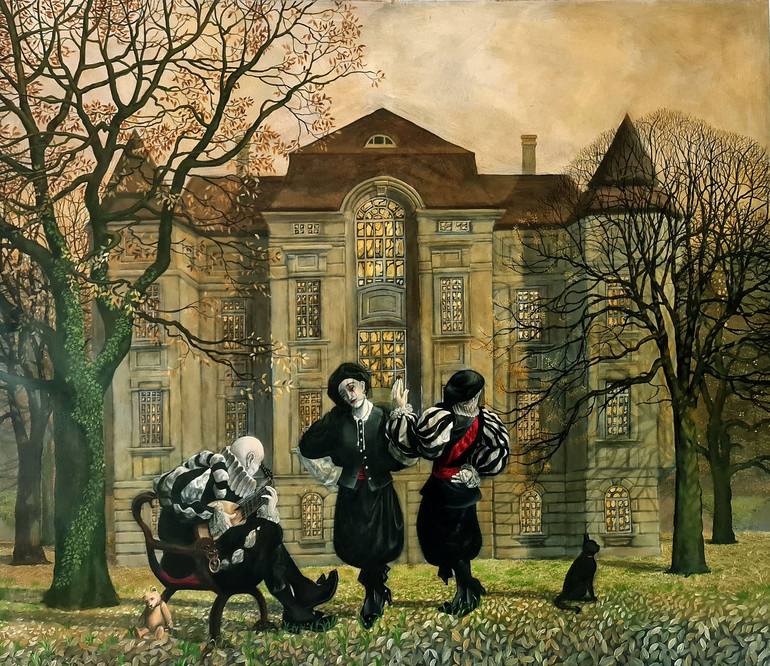


118 Views
1
View In My Room
Painting, Oil on Canvas
Size: 59.1 W x 51.2 H x 0.8 D in
Ships in a Crate
118 Views
1
ABOUT THE ARTWORK
DETAILS AND DIMENSIONS
SHIPPING AND RETURNS
For Christmas of 2019/2020 I became the owner of a Baroque Lute. From the age of 13 when I first heard Eugen Dombois seminal recording of works by Bach, Wiess and Kellner, I was mesmerised, (it was the first recording of a baroque lute EVER made). I fell immediately in love with that sound and fro...
Year Created:
2021
Subject:
Styles:
Mediums:
Painting, Oil on Canvas
Rarity:
One-of-a-kind Artwork
Size:
59.1 W x 51.2 H x 0.8 D in
Ready to Hang:
No
Frame:
Not Framed
Authenticity:
Certificate is Included
Packaging:
Ships in a Crate
Delivery Cost:
Shipping is included in price.
Delivery Time:
Typically 5-7 business days for domestic shipments, 10-14 business days for international shipments.
Returns:
14-day return policy. Visit our help section for more information.
Handling:
Ships in a wooden crate for additional protection of heavy or oversized artworks. Artists are responsible for packaging and adhering to Saatchi Art’s packaging guidelines.
Ships From:
Austria.
Need more information?
Need more information?
Ben Dhaliwal
Austria
Ben Dhaliwal’s artwork belongs to a world of atmosphere, narrative and above all nostalgia, perhaps for something never experienced. His landscapes and interiors are populated by archetypal figures. Magicians, Clowns, Kings, Queens, Angels, Performing Animals and characters from and inspired by his love of baroque opera. All of them have in common that they are figures out of place in the modern, materialist world. His performers stand as practitioners of either lost, pointless or superseded skills; much like any painter, especially one occupied with representational or figurative subject matter. The situations in which they are depicted are often either prior to or after an event to which the viewer has not been privileged and must therefore provide interpretation and meaning. Clues and symbols abound in the plethora of seemingly irrelevant objects which lie discarded in the corners and shadows of his theatrical spaces. His paintings are also rich in art historical references contrasted by deliberate anachronisms of textile, costume detail and furnishing. These are there to be enjoyed by those who care to take the time but are non-essential and subservient to the overall effect. The kitsch and sentimental content in his work is neither cool nor ironic but stems from a real desire to transcend and escape the sometimes oppressive hectic of the immediate. As a child of mixed-race parentage growing up in the grim, industrial north of 1970’s England, he claimed this right to non-participation relatively early, abandoning a practical study of art for the more esoteric but academically rigorous and critical theory-steeped, art history. Emerging years later, his head spinning with visual and cultural references, he embarked on a career as a museum curator. However, dissatisfied with the dreary politics and repetitive administration and having met his wife to be, he left England for Austria, initially planning to begin doctoral research. However, during this time, his desire to practice was re-kindled. After a brief and only partially successful attempt to try and establish a career as a children’s book illustrator, he began to practice the meticulous, studied and utterly un-spontaneous type of oil painting, based on the so called ‘Flemish Technique’ that he had always admired. Lacking conviction that his work had either aesthetic merit or commercial possibility, he did not exhibit until 2013.
Why Saatchi Art?
Thousands of
5-Star Reviews
We deliver world-class customer service to all of our art buyers.
Global Selection of Original Art
Explore an unparalleled artwork selection from around the world.
Satisfaction Guaranteed
Our 14-day satisfaction guarantee allows you to buy with confidence.
Support Emerging Artists
We pay our artists more on every sale than other galleries.
